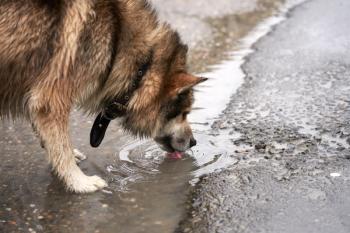
Neuropathology of Spontaneous Ischemic Stroke Is Similar Between Dogs and Humans
The neuropathology of spontaneous ischemic stroke in a Rottweiler resembled that of an ischemic stroke in a human.
A case report recently published in Acta Veterinaria Scandinavica described the neuropathology of a spontaneous ischemic stroke in a Rottweiler. The neuropathology resembled that of spontaneous ischemic stroke in humans, suggesting that dogs could serve as an experimental animal model for ischemic stroke.
Animal models have provided valuable insight into ischemic stroke pathophysiology. However, a translational research gap persists, possibly because these animal models cannot mimic the complexity of human strokes adequately. This gap contributes to a lack of effective neuroprotective drugs for human stroke patients.
A canine model could address this gap, in part because dogs and humans share several neuroanatomic features and stroke risk factors. In addition, neurologic signs and magnetic resonance imaging (MRI) findings of spontaneous ischemic stroke are similar between dogs and humans. Although ischemic stroke may occur less commonly in dogs than in humans, the neurologic similarities between the species support the possibility of a canine model for ischemic stroke.
The Case
At Denmark’s University Hospital for Companion Animals, an adult female Rottweiler presented with acute onset of left-sided hemiparesis and hemineglect. The dog had low thyroxine levels and elevated thyroid-stimulating hormone levels yet did not display clinical signs of hypothyroidism. MRI findings revealed a right middle cerebral artery (MCA) infarct. All other examination findings, including thromboelastography, were normal.
The dog’s owners elected euthanasia 3 days after initial presentation. The dog’s brain was then processed and sectioned transversely. Selected sections underwent histochemical staining and immunohistochemistry (IHC). IHC was performed to detect expression of Iba1 by microglia and glial fibrillary acidic protein (GFAP) by astrocytes.
Gross Examination
The right cerebral hemisphere contained a soft, edematous area with swollen, flattened gyri and narrowed sulci; this area, which had a distinct boundary, corresponded to MRI findings. The grey matter of several sulci had focal, petechial hemorrhages resulting from reperfusion injury. These hemorrhages suggested an embolism, but no embolus or thrombus was identified; the authors noted that rapid emboli reduction occurs in dogs.
A focal area of the neocortex was detached from the underlying white matter, indicating cortical laminar necrosis.
The right lateral ventricle was compressed. Subfalcine herniation, which occurs when part of the affected cerebral hemisphere herniates under the falx cerebri, was also present. This compression and herniation contributed to a midline shift toward the left cerebral hemisphere.
Gross examination findings indicated right MCA occlusion, which is a common subtype of canine and human spontaneous ischemic strokes.
Histopathology
Histologically, brain architecture was normal. Within the infarct, liquefactive necrosis and loss of neurons and glial cells were apparent. The peri-infarct area was also necrotic, with infiltration of neutrophilic granulocytes and microglia. The authors noted that the cause of neutrophilic infiltration following an ischemic stroke is not yet known. It is known, though, that microglia change their morphology and functionality after an ischemic brain injury.
Immunohistochemistry
Increased Iba1 expression in the peri-infarct area indicated microglial reactivity, which was strongest near the infarct. Reactive astrocytosis, indicated by increased GFAP expression, was also present in the peri-infarct area. Astrocytes, the authors wrote, become reactive following brain injury and can induce microglial reactivity.
Although further investigation of canine ischemic strokes is necessary, the authors stated that “important investigations of the pathophysiology of spontaneous ischaemic stroke in dogs may contribute to [bridging] the translational gap between human patients and experimental animal models.”
Dr. Pendergrass received her doctorate in veterinary medicine from the Virginia-Maryland College of Veterinary Medicine. Following veterinary school, she completed a postdoctoral fellowship at Emory University’s Yerkes National Primate Research Center. Dr. Pendergrass is the founder and owner of JPen Communications, LLC.
Newsletter
From exam room tips to practice management insights, get trusted veterinary news delivered straight to your inbox—subscribe to dvm360.




